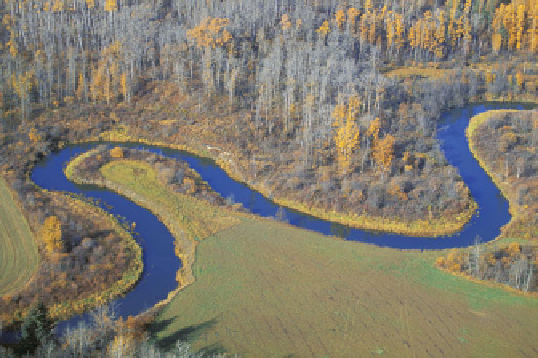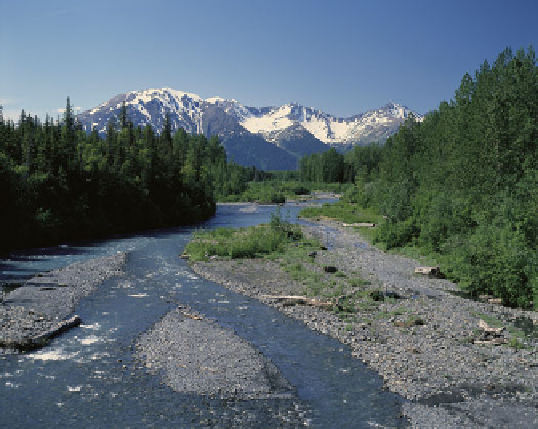Geoscience Reference
In-Depth Information
Bedload Transport and Braided Streams
Braided streams are interesting fluvial systems that develop
when the sediment they carry is predominantly bedload of
sand and gravel. To better visualize the characteristics of these
streams, go to the
Geo Media Library
and select
Bedload
Transport and Braided Streams
. This animation contains
three videos related to braided streams. The first video shows
the nature of bedload transport in flowing water. Subsequently,
a second video demonstrates the evolution of a braided system
in an experimental setting. The final clip shows the Platte River in
the central United States. This stream is one of the best-known
braided systems east of the Rocky Mountains. Once you com-
plete the exercise, answer the questions at the end to test your
understanding of this concept.
The amount and kind of sediment a stream can carry at
a given point are determined by a variety of complex factors
within the system that are related to the concept of
stream gra-
dation
. This concept is based on the fact that streams adjust
internally (by flowing faster, becoming wider, etc.) in a way that
allows them to maintain an equilibrium state with the surround-
ing environmental variables. In this context, it is essential to
view streams as holistic systems that can respond in many dif-
ferent ways. Imagine, for example, if a forest fire occurred that
removed the vegetation on hillslopes in an area—how would
the stream respond? Rill and gully erosion would increase and
more sediment would be delivered to streams because vegeta-
tion would no longer be present to protect the hillslopes from
heavy rain. In an effort to adjust to this higher sediment sup-
ply, much of the sediment would initially be deposited on the
channel bottom (because the stream could not carry it) in such
a way as to increase the overall stream gradient. This kind of
deposition, which raises the elevation of the channel bed, is
called
aggradation
. The increased gradient caused by aggrada-
tion would result in higher flow velocity and power that would,
in turn, enable the stream to carry the increased sediment load.
If hillslope vegetation was reestablished and erosion slowed
through time, the stream would require less energy to carry the
reduced sediment load. As a result, the stream would gradually
erode its channel bed in a process called
degradation
(or
down-
cutting
) until a new gradient was established that enabled the
stream to be able to carry just the lessened supply of sediment.
A stream in this equilibrium condition is referred to as a
graded
stream
because a balance exists among erosion, sediment load,
deposition, and the capacity of flowing water.
(a)
Aggradation
The progressive accumulation of sediment
along or within a stream.
(b)
Figure 16.19 Stream load and channel characteristics.
(a)
A meandering stream usually consists of a single channel that
winds back and forth across the landscape.(b) Braided streams
such as this one in Alaska consist of a maze of wide, shallow
Degradation
The topographic lowering of a stream channel
by stream erosion.














